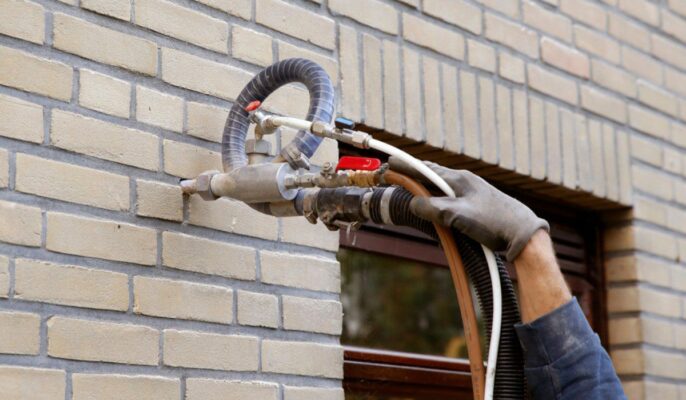Cavity walls are masonry walls that use spaces between bricks to create a strong and stable structure. The wall is constructed by filling the interior voids of the building with concrete.
This type of construction can be used for residential and commercial buildings, providing more energy efficiency than other wall types.
Cavity walls are typically built as exterior walls because they are less expensive than other structures. They are quite versatile in style and can be used for structural purposes if you want to add strength to your home or office building without replacing them entirely.
Source: Pinterest
Construction of Cavity Walls
Source: Pinterest
This type of wall comprises two parts: the outer layer and the inner layer. The outer layer is made up of blocks or panels filled with concrete, while the inner layer is made up of concrete poured into hollows in the outer layer to create an even surface for glazing.
- A cavity wall starts with precast concrete panels that are moulded together to create a hollow space.
- After the panels are poured, they are left to cure for several days before spraying with an epoxy coating.
- Once cured, the walls are finished with a coat of paint or stucco and then covered with vinyl or aluminium siding. They can also be left plain if desired.
- The bricks or stones are placed so that they fit together tightly. This creates the shape of the wall.
- The bricks or stones are then covered with mortar. The mortar is usually made up of lime and sand but can also be made up of clay or cement as well.
Purpose of Cavity Wall
- In addition to reducing the possibility of moisture intrusion between the outer and inner leaf, cavity walls also help to prevent dampness from entering the building.
- The inner leaf of the cavity, always a load-bearing wall, is protected from efflorescence because dampness cannot penetrate it.
- Cavity walls minimise heat from the outside to the inside as the air in the cavity acts as a non-conductor. By keeping cavity walls in place, a building remains thermally insulated.
- A cavity wall can act as a soundproof zone as it absorbs much external noise. By building cavity walls, a premise can become soundproof.
Cavity wall insulation
- For cavity walls made from 100 mm bricks and 100 mm blocks to meet building regulations, they must be well insulated.
- Insulating cavity walls can increase the thermal insulation qualities of a building.
- Cavity wall insulation is generally used to reduce heat loss through cavities.
- The majority of the time, it is done in cold regions where the climate is cold most of the year.
- It prevents condensation and ensures less heat is lost through the walls.
- Polyurethane, glass fibre wool, and rock wool panels are commonly used for cavity wall insulation.
- Cellulose insulation is used to make this building soundproof. It is a low-conductive material.
Types
Mineral wool or Rock wool: The mineral wool in cavity walls is usually made of igneous rock which is heated and spun into fibres. It is commonly used for residential insulation.
In addition to being water-resistant, this material is capable of preventing moisture intrusion caused by rain, which usually enters through the outer leaf of a wall into the interior leaf.
Polystyrene bead: Some stone-built homes also prefer mixing the beads with an adhesive before pushing them into the wall cavity to keep the beads from spilling outside the cavity.
An adhesive is mixed with the beads and pushed into the cavities of the walls to ensure the beads do not spill outside.
Cavity foam insulation: A benefit of this insulation material is that it can be inserted into walls or brickwork by drilling smaller holes. Mineral wool or polystyrene beads are the preferred insulation materials if the work is performed solely for thermal insulation.
Benefits of cavity walls
Cavity walls offer several advantages over other types of construction.
Cost effective
Cavity walls are a trendy choice for home construction. They are very cost-effective and can be built in any shape.
Energy efficient
They increase energy efficiency because they use less material than conventional walls with regular masonry or concrete block construction methods.
Not labour intensive
They require less labour on average than other types because workers can build them without digging trenches or pouring the foundation.
More robust
They are firm because they have no joints between the bricks or stones. Unlike other types of walls, they can withstand external forces such as earthquakes without showing signs of wear and tear or cracking.
Easy repair
They are easy to repair if any damage occurs due to fire or water damage. All that needs to be done is remove some bricks or stones around the affected area, making it easier for workers who need to clean up after such an event.
Could be used as solar panels
Cavity walls are also well suited to being used as solar panels because they have a lot of surface area. Which means they can absorb the sun’s rays and heat up.
Disadvantages of cavity walls
- The construction of cavity walls requires highly skilled workers and masons.
- Construction of such walls must be supervised according to standard procedures.
- It requires a vertical damp-proof course.
- There is the possibility of unfilled air pockets on the inside walls causing cold spots.
- Even the best insulation materials are susceptible to moisture intrusion.
FAQs
How does a cavity in a wall work?
Cavity walls comprise two walls with a cavity between them.
Why are cavity walls beneficial?
Thermal insulation is better in cavity walls than in solid walls.
